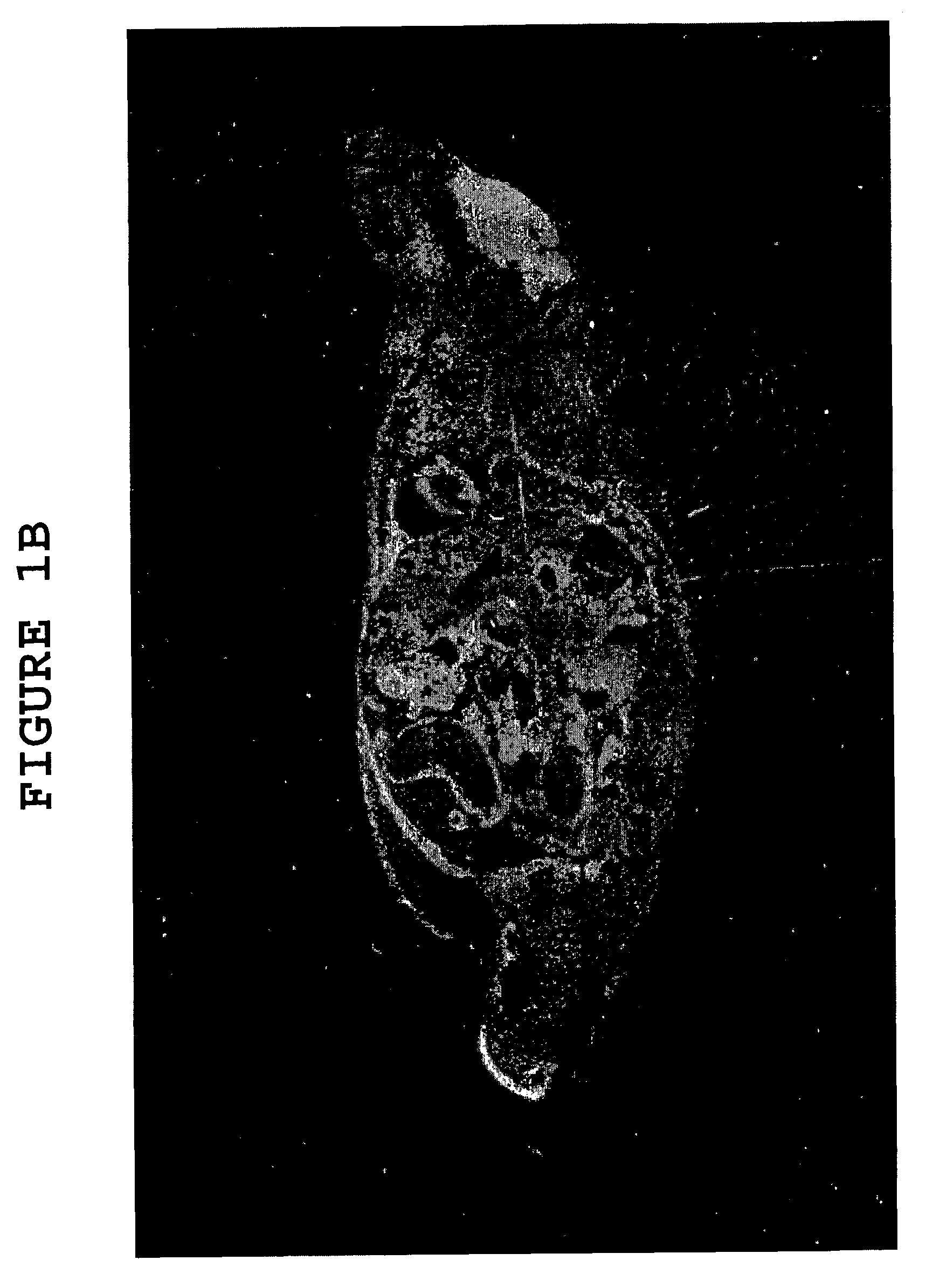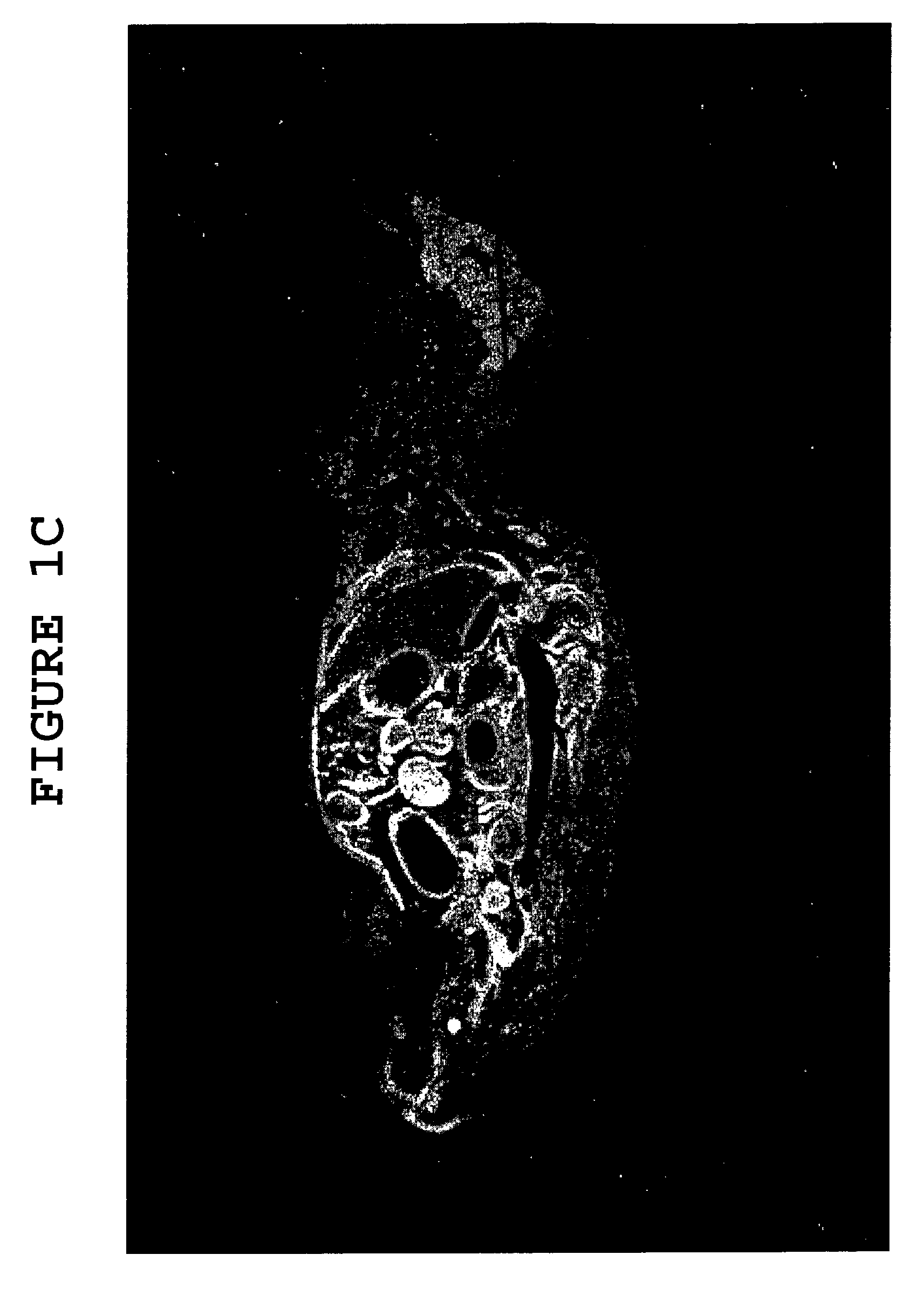Methods and compositions for delivering enzymes and nucleic acid molecules to brain, bone and other tissues
a technology of enzymes and nucleic acids, applied in the direction of drug compositions, biocides, peptide/protein ingredients, etc., can solve the problems of corneal clouding and deformation of hands, abnormalities in brain and bone marrow, bone, cartilage and brain,
- Summary
- Abstract
- Description
- Claims
- Application Information
AI Technical Summary
Benefits of technology
Problems solved by technology
Method used
Image
Examples
example 1
Effect of Hyaluronidase on Evans Blue Staining of Brain Tissue
[0077]Evans Blue was used to demonstrate the action of hyaluronidase on the blood-brain barrier. Evans Blue binds to albumin when injected. The albumin is a large molecule with a high molecular weight (approximately 66 kDa) and does not cross the blood-brain barrier. Evans Blue was injected into an experimental mice, and 15 minutes thereafter, hyaluronidase was administered subcutaneously to some of the experimental mice. The following day, the mice with and without hyaluronidase were sacrificed, and the brains were examined for Evans Blue stain. Only the mice with the hyaluronidase had Evans Blue stain in the brain, indicating the albumin with Evans Blue attached to it crossed the blood-brain barrier.
example 2
Effect of Hyaluronidase on Albumin Penetration into Brain Tissue as Demonstrated Using Anti-Albumin Antibody-Peroxidase Conjugate
[0078]To further demonstrate the effect of hyaluronidase on the ability of large molecules to cross the blood brain barrier (“BBB”), uncomplexed albumin was administered to two groups of mice, one group having received hyaluronidase pretreatment (as described in Example 1) and the other having received no such pretreatment. Following administration of the albumin, the mice with and without hyaluronidase pretreatment were sacrificed, and cortex and cerebellum sections of their brains were treated with an anti-albumin antibody-peroxidase conjugate which stains albumin brown. The cortex and cerebellum sections of both groups of mice were also stained with the common microscopy stain hematoxylin / eosin, which stains glial cells blue.
[0079]Cortex sections of mice from the group which did not receive hyaluronidase pretreatment, taken 3 hours after albumin adminis...
example 3
Effect of Hyaluronidase on FITC-Dextran Penetration into Various Tissues
[0083]Dextran tagged with the fluorescent dye fluorescein isothiocyanate (“FITC-Dextran”) (Sigma Chemicals) was used to demonstrate the action of hyaluronidase on the blood brain barrier, on bone, and on other tissues such as kidney and liver. The dextran is a large molecule of high molecular weight (approximately 400 kDa) and does not cross the blood brain barrier or penetrate into bone.
[0084]Mice of the same age (6 months) were injected intraperitoneally (“IP”) with 1000 units hyaluronidase (Sigma Chemicals), followed 15 minutes later with IP injection of 150 mg FITC-Dextran. The mice were then subjected to whole-body fluorescent imaging, using a modification of the method described in Ullberg, “The Technique of Whole-Body Autoradiography. Cryosectioning of Large Specimens,” pp. 2-29 in Alvfeldt, ed., Science Tools, Special Issue on Whole-Body Autoradiography, LKB Instrument Journal, Bromma, Sweden: LDK Produc...
PUM
| Property | Measurement | Unit |
|---|---|---|
| time | aaaaa | aaaaa |
| time | aaaaa | aaaaa |
| time | aaaaa | aaaaa |
Abstract
Description
Claims
Application Information
 Login to View More
Login to View More - R&D
- Intellectual Property
- Life Sciences
- Materials
- Tech Scout
- Unparalleled Data Quality
- Higher Quality Content
- 60% Fewer Hallucinations
Browse by: Latest US Patents, China's latest patents, Technical Efficacy Thesaurus, Application Domain, Technology Topic, Popular Technical Reports.
© 2025 PatSnap. All rights reserved.Legal|Privacy policy|Modern Slavery Act Transparency Statement|Sitemap|About US| Contact US: help@patsnap.com



